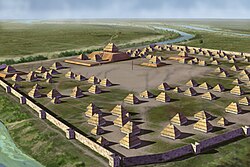Parkin Indian Mound | |
 Artist's conception of the archaeological site | |
| Nearest city | Parkin, Arkansas |
|---|---|
| Coordinates | 35°16′37.70″N 90°33′26.66″W / 35.2771389°N 90.5574056°W |
| NRHP reference No. | 66000200 |
| Significant dates | |
| Added to NRHP | October 15, 1966[1] |
| Designated NHL | July 19, 1964[2] |
Parkin Archeological State Park, also known as Parkin Indian Mound, is an archeological site and state park in Parkin, Cross County, Arkansas. Around 1350–1650 CE an aboriginal palisaded village existed at the site, at the confluence of the St. Francis and Tyronza rivers. Artifacts from this site are on display at the site museum. The Parkin site is the type site for the Parkin phase, an expression of the Mississippian culture from the Late Mississippian period. Many archeologists believe it to be part of the province of Casqui, documented as visited by Spanish explorer Hernando de Soto in 1542. Archeological artifacts from the village of the Parkin people are dated to 1400–1650 CE.
The Parkin site was declared a National Historic Landmark in 1964 for its significance as a type site of the Parkin phase.[2][3] In 1966, the Parkin Indian Mound was listed in the National Register of Historic Places.[1] Parkin Archeological State Park is located at 60 Arkansas Highway 184 North, Parkin, Arkansas.
- ^ a b "National Register Information System". National Register of Historic Places. National Park Service. January 23, 2007.
- ^ a b "Parkin Indian Mound". National Historic Landmark summary listing. National Park Service. September 26, 2007.
- ^ Mark R. Barnes (November 25, 1997). "Parkin Indian Mound" (PDF). National Historic Landmark Nomination. National Park Service. Retrieved February 22, 2009.

